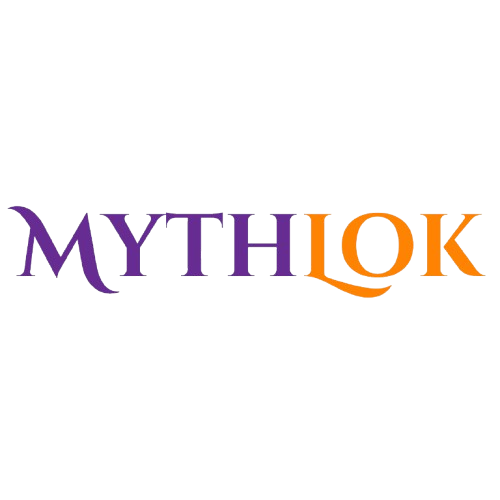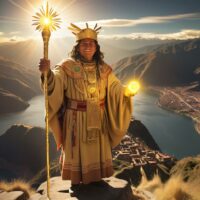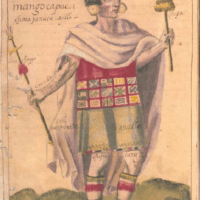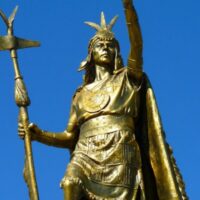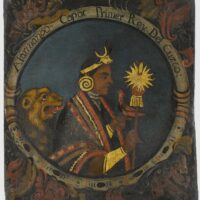Manco Capac : The Founding Father
Listen
At a glance
| Description | |
|---|---|
| Origin | Inca Mythology |
| Classification | Demigods |
| Family Members | N/A |
| Region | Peru, Bolivia |
| Associated With | Founding City |
Manco Capac
Introduction
Manco Capac is celebrated as the legendary founder of the Inca Empire and stands as a monumental figure in Andean mythology. Often described as a divine emissary, Manco Capac’s journey and deeds symbolize the genesis of civilization in the highlands of Peru. Blending the sacred with the historical, his story has been passed down through generations as a vital part of Inca cosmology. Whether emerging from the depths of Lake Titicaca or a mythical cave in the mountains, his rise marks the beginning of order, agriculture, and structured governance among the Inca people.
Physical Traits
Descriptions of Manco Capac’s physical appearance are shaped more by legend than verified records. Though ancient chronicles provide only faint sketches, they imbue him with divine qualities. Depictions often show him dressed in regal garments adorned with gold, his attire setting him apart from ordinary mortals. He is said to have carried a golden staff, known as the tapac-yauri, which glowed with spiritual energy and served as a divine compass in his quest to find a suitable place to establish the Inca capital. These portrayals emphasize not just his leadership but also his sacred status, reflecting how Inca society viewed their founder as more than human.
Family
Manco Capac’s origins are rooted in the divine. In the most prominent legend, he is the son of Inti, the sun god, and Mama Quilla, the moon goddess. His divine parentage was more than symbolic—it legitimized his authority and the Inca claim of being descendants of celestial beings. His story is incomplete without Mama Ocllo, his sister and wife, who accompanied him on his civilizing mission. Their relationship represents the harmonious union of masculine and feminine forces working together to guide humanity.
In another version of the myth, known as the Ayar Brothers legend, Manco Capac—also called Ayar Manco—is one of several siblings emerging from a cave at Pacaritambo. He traveled with three brothers and four sisters, each representing different traits and destinies. Among them, Mama Ocllo stands out as his loyal partner. These familial connections are foundational to Inca myths, illustrating themes of unity, divine purpose, and structured kinship.
His son, Sinchi Roca, continued the royal lineage, becoming the second ruler and reinforcing the notion that the Inca rulers were a continuation of divine will. While historical evidence around this succession is sparse, the mythological framework provided a powerful justification for dynastic rule.
Other names
Manco Capac is known by various titles across different narratives. In Quechua, the language of the Inca people, he is often referred to as Manqu Qhapaq, meaning “the royal founder” or “mighty lord.” In the version involving the Ayar siblings, he appears as Ayar Manco, reflecting his mythological context as part of a divine sibling group. Another name, Manco Inca, is more commonly used in colonial accounts and historical records.
These variations underscore his layered identity. Some traditions even regard him as an incarnation of fire or as a sun god himself, reinforcing his deep association with cosmic forces. The term Capac, meaning “warlord” or “powerful one,” highlights his role not just as a ruler but as a divine enforcer of order and civilization.
Powers and Abilities
Manco Capac’s abilities set him apart as both a spiritual leader and a civilizing hero. His most iconic tool, the golden staff, was said to have been gifted by his father Inti. This staff was more than a symbol—it guided him to the site where Cusco, the Inca capital, was to be founded. It would sink into the ground at the spot chosen by the gods, signaling where he should begin his mission.
His teachings transformed the lives of early humans. Manco Capac introduced agriculture, instructing men on how to cultivate maize and build irrigation systems. He also introduced religious rituals, creating a system of worship centered on the sun god, which became the spiritual backbone of the Inca Empire.
In matters of governance, Manco Capac laid the groundwork for a structured society. He organized labor through the ayllu system and introduced the mit’a, a form of communal work that contributed to the construction of temples, roads, and public projects. These innovations helped turn a collection of tribes into a cohesive and powerful empire.
Later interpretations, especially in literature and modern retellings, attribute more fantastical powers to him. Some accounts describe him as immortal, capable of telepathic communication and even manipulating the elements. These modern embellishments, while not rooted in traditional Inca stories, demonstrate the lasting fascination with his figure.
Modern Day Influence
Manco Capac’s legacy resonates deeply in contemporary Peru and beyond. His story is central to the identity of the Andean people and continues to be celebrated through various cultural events and public commemorations. Cusco, the city he is said to have founded, remains a vibrant testament to his influence. It stands as a UNESCO World Heritage Site and a pilgrimage site for those honoring their Inca ancestry.
During the annual Inti Raymi festival, actors reenact his arrival and founding of Cusco in elaborate ceremonies that draw crowds from around the world. These events not only celebrate Inca heritage but also serve as a form of cultural revival and resistance, especially for indigenous communities seeking to reclaim their narratives.
In academic circles, Manco Capac has been interpreted through different lenses. Enlightenment thinkers admired him as a symbol of wise and just leadership. Others criticized the myths surrounding him as superstition, showing how his story has been contested and reinterpreted through time. His name appears in literature, comics, and even children’s media. For example, in the comic The Son of the Sun, Manco Capac is portrayed as the original owner of a great treasure, while in Herman Melville’s The Confidence-Man, his name evokes themes of origin and deception.
Today, Manco Capac represents more than just a mythical king. He embodies the enduring spirit of the Inca civilization—its ingenuity, spirituality, and sense of community. His story continues to inspire pride, unity, and cultural identity among the descendants of the Inca people, anchoring them to a past that still speaks powerfully in the present.
Related Images
Source
Encyclopedia.com. (2018). Manco Capac. In UXL Encyclopedia of World Mythology. Retrieved June 17, 2025, from https://www.encyclopedia.com/people/history/south-american-indigenous-peoples-biographies/manco-capac
Mythology Worldwide. (2024). The legend of Manco Capac: Founder of the Incan civilization. Retrieved from https://mythologyworldwide.com/the-legend-of-manco-capac-founder-of-the-incan-civilization/
Wikipedia contributors. (2025, June 17). Manco Cápac. Wikipedia. Retrieved from https://en.wikipedia.org/wiki/Manco_C%C3%A1pac
Archive.org. (n.d.). Manco Capac. Retrieved from https://archive.org/download/manco-capac
EBSCO. (2025). Manco Capac: Founder of the Incan Empire. Research Starters. Retrieved from https://www.ebsco.com/research-starters/history/manco-capac
de Gamboa, P. S. (2015). History of the Incas. Lexington. ISBN: 9781463688653
Soriano, W. E. (1990). Los Incas: Economía, sociedad y estado en la era del Tahuantinsuyo. Amaru Editores. ISBN: 84-7090-300-4
Pugh, H. (2020). Intrepid Dudettes of the Inca Empire. Independently published. ISBN: 9781005592318
Frequently Asked Questions
What is lorem Ipsum?
I am text block. Click edit button to change this text. Lorem ipsum dolor sit amet, consectetur adipiscing elit. Ut elit tellus, luctus nec ullamcorper mattis, pulvinar dapibus leo.
What is lorem Ipsum?
I am text block. Click edit button to change this text. Lorem ipsum dolor sit amet, consectetur adipiscing elit. Ut elit tellus, luctus nec ullamcorper mattis, pulvinar dapibus leo.
What is lorem Ipsum?
I am text block. Click edit button to change this text. Lorem ipsum dolor sit amet, consectetur adipiscing elit. Ut elit tellus, luctus nec ullamcorper mattis, pulvinar dapibus leo.
What is lorem Ipsum?
I am text block. Click edit button to change this text. Lorem ipsum dolor sit amet, consectetur adipiscing elit. Ut elit tellus, luctus nec ullamcorper mattis, pulvinar dapibus leo.
What is lorem Ipsum?
I am text block. Click edit button to change this text. Lorem ipsum dolor sit amet, consectetur adipiscing elit. Ut elit tellus, luctus nec ullamcorper mattis, pulvinar dapibus leo.

